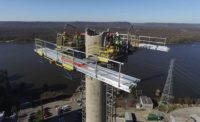As with most other Midwest contractors, Chicago-based Pepper Construction has strived to make the most of a strong economy. The 1,110-person company’s regional revenue has increased 112% over the past five years, reaching $1.25 billion during the fiscal year that ended in September. That places Pepper Construction fifth among companies in the 11-state region that participated in ENR Midwest’s Top Contractors survey, up three spots from the previous year.
Some of Pepper’s revenue-boosting initiatives mirror those of other contractors—such as self-performing concrete and drywall work. What has helped bolster the balance sheet, insists Stan Pepper, chairman and CEO, has been a concerted years-long investment in people and technology organized as the integrated construction services (ICS) group, with approximately 50 staff members distributed across all six Pepper Construction offices.
Stan Pepper says that effort, aimed at improving project delivery and providing greater value to clients, began to demonstrate its full potential last year.
“We’re able to execute projects better than before, including identifying things clients should be thinking about earlier in the process,” he says.
Led by vice president Jake Pepper, Stan’s son, the ICS group combines preconstruction and scheduling services with building technology tools, ranging from BIM software to Microsoft HoloLens and infrared scanning.
“ICS allows us to go well beyond what can be typically done with 3D models,” explains Jake Pepper. “We can work with the design team to design and build to budget, rather than starting with a design and value-engineering things out.”
“We want to show that we’re open to new ways of doing things, in addition to providing resources and opportunities that we hope will make [people] want to spend their careers with us,”
– Jake Pepper, Vice President, Pepper Construction
Pepper has cultivated expertise in high-performance buildings, stressing the value of integrating systems and design elements for energy conservation, healthier/more productive environments and operational efficiency. A company-developed building performance tool aids in sharing these insights with clients by analyzing program decisions with comparisons of operational and construction costs, return on investment and payback periods.
“We offer these ideas as suggestions, but it’s up to the owner to make final decisions,” Stan Pepper says.
That includes the example of a net-zero jobsite trailer, which debuted at Greenbuild in Chicago.
An in-house development team, led by Susan Heinking, Pepper’s vice president of sustainable construction, used BIM and energy modeling to shrink the trailer’s carbon footprint to zero while also ensuring its ruggedness for repeated use. In addition to using locally sourced materials, the team built the trailer using Microsoft HoloLens rather than paper drawings.
“We’re using the net-zero trailer to not only inspire ourselves as high-performance contractors, but also to increase our clients’ awareness of the value of creating healthy working environments,” Jake Pepper says.
That’s not limited to humans. Pepper is helping the Cincinnati Zoo & Botanical Garden develop a master plan to become the world’s first net-zero zoo by 2030.
Mark Fisher, the zoo’s vice president for facilities, planning and sustainability, calls Pepper’s use of technology “a game changer,” turning what had been a trial-and-error approach to sustainability into a more strategic, organized effort.
Data from Pepper’s thermal imaging technology revealed that previous insulation upgrades were less effective than thought.
“They have all the tools that give us access to information we never had,” Fisher says.
The same is true for proposed buildings, where layouts, materials and other attributes can be manipulated and analyzed during the design stage to fine-tune both cost and performance.
“That data gives us a lot of confidence in the decisions we’re making,” Fisher adds.
Innovative construction approaches figure prominently in many of Pepper’s projects. Along with the six-year makeover of Wrigley Field, scheduled for completion next year, the company is working with Clif Bar & Co. to fulfill a biophilic design for a 24,000-sq-ft manufacturing facility in Indianapolis.
High-Tech Tools for High-Profile Projects
Jake Pepper believes the company’s technology focus is a key differentiator.
“We want to show that we’re open to new ways of doing things, in addition to providing resources and opportunities that we hope will make [people] want to spend their careers with us,” he says, noting that the types of roles created within the ICS group previously did not exist.
Stan Pepper adds that the company has stressed collaboration across its multigenerational workforce, from his “World War II generation” father, Richard, who remains active in the company’s leadership, to this year’s class of 29 post-millennial, Generation Z interns.
“We encourage sharing ideas and respecting each other’s points of view,” he says. “It’s a good mix that ultimately helps us do the right thing for ourselves and our clients.”
Inspiring a new generation of construction innovators is another of Pepper’s priorities. The company provides hands-on demonstrations and mentoring to an annual conference sponsored by the Crystal Lake, Ill., district of Girls in Engineering Math & Science (GEMS), which provides opportunities for girls in grades 6-8 to explore STEM careers.
As part of its work on St. Rita’s Square, a 182,000-sq-ft independent and assisted living building in Milwaukee, Pepper “adopted” a seventh-grade class at nearby Cass Street School, creating a STEM curriculum that includes demonstrations of construction technology, site tours/scavenger hunts and the chance to learn to lay bricks.
Alicia Dupies, senior vice president with Capri Communities, says the sessions, which “cost Pepper a day of productivity,” are well liked by the students. The sessions will continue next year when the students return as eighth graders.
“Everything we’ve asked, they’ve done with enthusiasm and grace, often taking it a step further,” Dupies says.
Jake Pepper is heartened by the prospect that some of these students may choose construction as a career, perhaps with Pepper. After all, new ideas and perspectives will be critical in what is sure to be an even faster-paced future.
“We’ll see more change in the next five years than in the last fifty,” says Jake Pepper. “There are some really disruptive things on the horizon, and we’re trying to stay on top of it.”
Though technology can help any contractor improve, adds Stan Pepper, “technology with good people is fantastic.”






Post a comment to this article
Report Abusive Comment